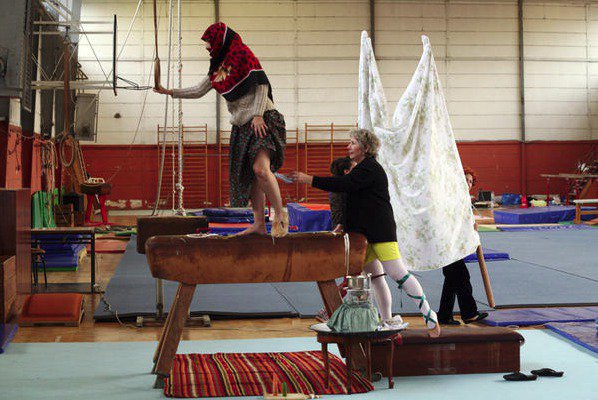Desiring the real
dal 18/4/2012 al 19/5/2012
Segnalato da
Iris Andraschek
Catrin Bolt
Adriana Czernin
Josef Dabernig
Judith Fegerl
Rainer Gamsjaeger
Michael Goldgruber
Nilbar Gueres
Maria Hahnenkamp
Siggi Hofer
Michael Hoepfner
Franz Kapfer
Leopold Kessler
Ulrike Koenigshofer
Hubert Lobnig
Bele Marx
Anna Mitterer
David Moises
Bernd Oppl
Margherita Spiluttini
Esther Stocker
Hannes Zebedin
Karin Zimmer
18/4/2012
Desiring the real
Museum of Contemporary Art - MoCAB, Belgrade
Austria Contemporary. The exhibition presents works by Austrian artists who explore different models of reality and place this notion at the centre of their work. The show is about subjectively experienced reality, staged reality, but also about developing alternative solutions and spaces for reality and contrasting them with one's own concept of what is 'real'.

curated by Karin Zimmer
Participating Artists: Iris Andraschek, Catrin Bolt, Adriana Czernin, Josef Dabernig, Judith Fegerl, Rainer Gamsjäger, Michael Goldgruber, Nilbar Güres, Maria Hahnenkamp, Siggi Hofer, Michael Höpfner, Franz Kapfer, Leopold Kessler, Ulrike Königshofer, Hubert Lobnig, Bele Marx, Anna Mitterer, David Moises, Bernd Oppl, Margherita Spiluttini, Esther Stocker, Hannes Zebedin
The exhibition is to be opened by:
Dr. Claudia Schmied, Federal Minister of Education, Arts and Culture of the Republic of Austria
Predrag Marković, Minister of Culture, Information and Information Society of the Republic of Serbia
Branislava Anđelković, Director of the Museum of Contemporary Art, Belgrade
The exhibition “Desiring the Real “presents works by Austrian artists who explore different models of reality and place this notion at the centre of their work. The show is about subjectively experienced reality, staged reality, but also about developing alternative solutions and spaces for reality and contrasting them with one’s own concept of what is “real”.
Why are questions of reality and truth so important today? Very often, aesthetic output in the various art disciplines is linked in different ways to what happens in the political arena. With their work, artists such as Nilbar Gures, Maria Hahnenkamp, Franz Kapfer, Leopold Kessler, Hubert Lobnig and Hannes Zebedin introduce us to issues of social criticism or gender policies. They challenge the seductive force of power in our society; they make “political art”. They do it, among other things, because they want to “puncture and broaden the clogged sphere of societal action” (Hannes Zebedin). They raise questions about the relationship between art, reality and politics and, in their works of art, broaden and develop reality.
There is no clear-cut borderline between reality and fiction. Artists have always liked to cross that border. “Reality and fiction merge in an endless horizontality, a shadow less landscape. Where the real world has turned illusionary, the illusionary world has taken on the garb of reality.” From the intertwined strands of reality and fiction we craft our own personal perception of the world.
Realität und Ritual (Reality and Ritual) is the title of a piece by Iris Andraschek. The photographs and drawings depict e people who inscribe themselves into a different reality for a certain time. Staged reality, or reality as a construct are the issues addressed by Iris Andraschek, Catrin Bolt, Rainer Gamsjager, Siggi Hofer, Ulrike Konigshofer, Anna Mitterer and Bernd Oppl. Their works are not a representation of reality, but fashion their own version of it beyond objective reality.
Judith Fegerl, Michael Goldgruber, Michael Hopfner, Bele Marx and Margherita Spiluttini explore and occupy places, turning insides out. They free spaces from their function and interpret a real-life place not only as a geographical given but as a locus of experience and imagination. They trace what the eye sees in the countryside, their concerns are the minimal changes, the interventions, the quest for our whereabouts, “for the place that people create in order to be the person they are or could be” (Peter Sloterdijk).
Finding and dissecting things, shifts, analysis and abstraction and the creation of new orders and constructs, always linked to social identities and personal situations – those are the issues addressed in different ways by Adriana Czernin, Josef Dabernig, David Moises and Esther Stocker.
Desiring the Real is an exhibition about re-ordering our experiences of reality, about different approaches to images and, thus, about re-ordering the world of the visible, conceivable and possible. The exhibition is also about the beauty of individual works of art and, even more so, about human beings, their social attachments, their expectations and yearnings. Having a commonly shared view of reality does not seem to be an option.
The exhibition presents a small part of the national collection of contemporary Austrian art, called "Artothek des Bundes". Since 1945 funds from the national art funding budget have been used to establish a big art collection, by now almost 30.000 pieces of art. The Austrian state buys art in order to support yong artists.
The exhibiton will travel to different countries, first station is MOCAB (Museum of Contemporary Art Belgrade, Serbia), afterwards the exhibition will travel to the Mexico, Kuba, Germany, Croatia, Turkey, Russia.
Supported by Federal Ministry of Education, Arts and Culture of the Republic of Austria and The Ministry of Culture, Information and Information Society of the Republic of Serbia
Image: Nilbar Gures, Unknown Sports, 2009
Opening on Thursday, April 19, 2012, 7:00 p.m.
Museum of Contemporary Art Belgrade /
Gallery-Legacy of Milica Zoric and Rodoljub Colakovic
Rodoljuba Colakovica Street 2, Belgrade
Working hours: from 12PM until 8PM, except on Tuesdays



